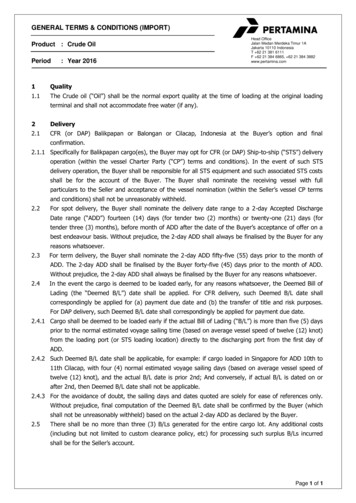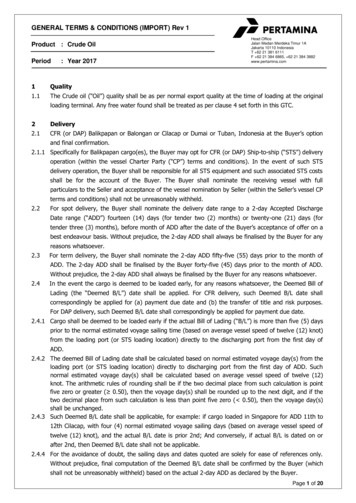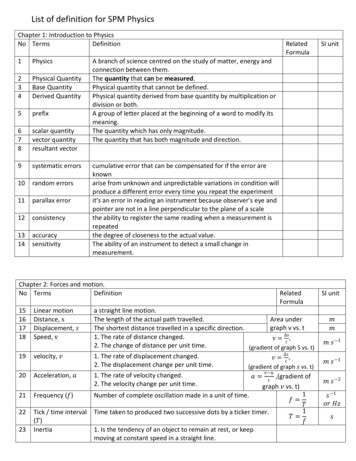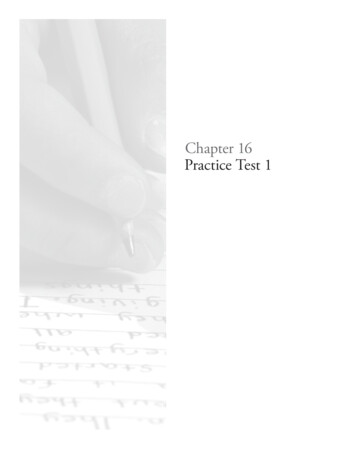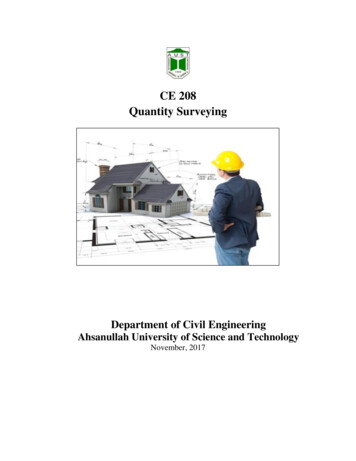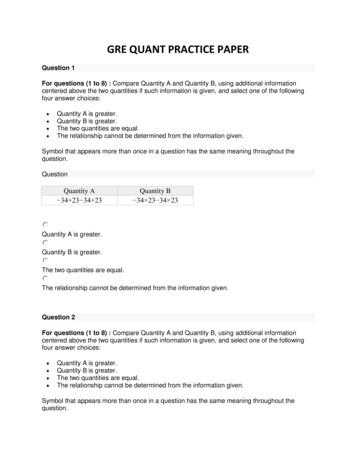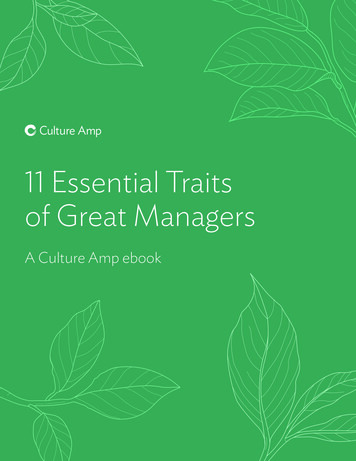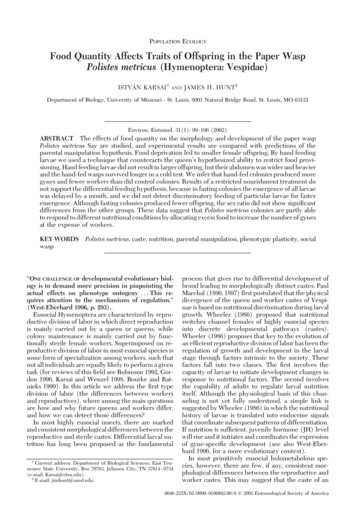
Transcription
POPULATION ECOLOGYFood Quantity Affects Traits of Offspring in the Paper WaspPolistes metricus (Hymenoptera: Vespidae)ISTVÁN KARSAI1ANDJAMES H. HUNT2Department of Biology, University of Missouri - St. Louis, 8001 Natural Bridge Road, St. Louis, MO 63121Environ. Entomol. 31(1): 99Ð106 (2002)ABSTRACT The effects of food quantity on the morphology and development of the paper waspPolistes metricus Say are studied, and experimental results are compared with predictions of theparental manipulation hypothesis. Food deprivation led to smaller female offspring. By hand feedinglarvae we used a technique that counteracts the queenÕs hypothesized ability to restrict food provi sioning. Hand feeding larvae did not result in larger offspring, but their abdomen was wider and heavierand the hand-fed wasps survived longer in a cold test. We infer that hand-fed colonies produced moregynes and fewer workers than did control colonies. Results of a restricted nourishment treatment donot support the differential feeding hypothesis, because in fasting colonies the emergence of all larvaewas delayed by a month, and we did not detect discriminatory feeding of particular larvae for fasteremergence. Although fasting colonies produced fewer offspring, the sex ratio did not show signiÞcantdifferences from the other groups. These data suggest that Polistes metricus colonies are partly ableto respond to different nutritional conditions by allocating excess food to increase the number of gynesat the expense of workers.KEY WORDS Polistes metricus, caste, nutrition, parental manipulation, phenotypic plasticity, socialwasp“ONE CHALLENGE OF developmental evolutionary biol ogy is to demand more precision in pinpointing theactual effects on phenotype ontogeny. . . . This re quires attention to the mechanisms of regulation.”(West-Eberhard 1996, p. 293).Eusocial Hymenoptera are characterized by repro ductive division of labor in which direct reproductionis mainly carried out by a queen or queens, whilecolony maintenance is mainly carried out by func tionally sterile female workers. Superimposed on re productive division of labor in most eusocial species issome form of specialization among workers, such thatnot all individuals are equally likely to perform a giventask (for reviews of this Þeld see Robinson 1992, Gor don 1996, Karsai and Wenzel 1998, Bourke and Rat nieks 1999). In this article we address the Þrst typedivision of labor (the differences between workersand reproductives), where among the main questionsare how and why future queens and workers differ,and how we can detect those differences?In most highly eusocial insects, there are markedand consistent morphological differences between thereproductive and sterile castes. Differential larval nu trition has long been proposed as the fundamental1Current address: Department of Biological Sciences, East Ten nessee State University, Box 70703, Johnson City, TN 37614 Ð 0734(e-mail: Karsai@etsu.edu).2E-mail: jimhunt@umsl.edu.process that gives rise to differential development ofbrood leading to morphologically distinct castes. PaulMarchal (1896, 1897) Þrst postulated that the physicaldivergence of the queen and worker castes of Vespi nae is based on nutritional discrimination during larvalgrowth. Wheeler (1986) proposed that nutritionalswitches channel females of highly eusocial speciesinto discrete developmental pathways (castes).Wheeler (1986) proposes that key to the evolution ofan efÞcient reproductive division of labor has been theregulation of growth and development in the larvalstage through factors intrinsic to the society. Thesefactors fall into two classes. The Þrst involves thecapacity of larvae to initiate development changes inresponse to nutritional factors. The second involvesthe capability of adults to regulate larval nutritionitself. Although the physiological basis of this chan neling is not yet fully understood, a simple link issuggested by Wheeler (1986) in which the nutritionalhistory of larvae is translated into endocrine signalsthat coordinate subsequent patterns of differentiation.If nutrition is sufÞcient, juvenile hormone (JH) levelwill rise and it initiates and coordinates the expressionof gyne-speciÞc development (see also West-Eber hard 1996, for a more evolutionary context).In most primitively eusocial holometabolous spe cies, however, there are few, if any, consistent mor phological differences between the reproductive andworker castes. This may suggest that the caste of an0046-225X/02/0099Ð0106 02.00/0 2002 Entomological Society of America
100ENVIRONMENTAL ENTOMOLOGYindividual is not Þxed at eclosion, thus leaving room forßexibility in which social factors, such as presence orabsence of brood, can lead to physiological changes innewly emerged adult females that then lead to castedifferentiation. Solṍs and Strassmann (1990) argue thatunpredictable social and ecological environments fa vor caste ßexibility over preimaginal determination inthe paper wasp Polistes exclamans Viereck. In Wheeler(1986, Þgure 3) Polistes is shown to be different fromother social insects in two manners. First, JH plays arole in caste determination in the early adult stage, andsecond, in other taxa gynes have high and workers lowlevels of JH, but in Polistes both have low levels withonly the colony queen having a high level. It is difÞcultto understand what these differences may mean, be cause there are apparently no available studies of JHfunction in solitary wasps, and JH not only seems toregulate reproductive division of labor but also divi sion of tasks among workers (Robinson 1992) andsocial dominance behavior (Röseler et al. 1985) aswell. However, there is accumulating evidence thatthere is some preimaginal biasing of caste in at leastsome primitively eusocial species (Grechka 1986;Grechka and Kipyatkov 1883; Rossi and Hunt 1988;Gadagkar et al. 1990, 1991; Hunt 1991; but see Fieldand Foster 1999). OÕDonnell (1998) suggests that thesame developmental mechanism may play a role incaste determination throughout Vespidae, in speciesof all grades of social complexity.Wheeler (1986) presented a developmental view ofthe evolution of insect societies as a bridge betweenevolutionary theories (Hamilton 1964a, 1964b; Lin andMichener 1972; West-Eberhard 1975) and theoriesfocused on insect societies as superorganisms (Osterand Wilson 1978). We agree with Wheeler (1986) thatevolutionary and mechanistic views are not necessar ily contradictory. Understanding mechanisms bywhich insect societies are integrated and regulatedcan lead us to a more reliable formulation of evolu tionary hypotheses. West-Eberhard (1996) proposedan explanation of the origin of reproductive castes by“reciprocal deletion,” where the ancestral reproduc tive cycle is decoupled into two parts, with one partexpressed in workers and the other in queens (see alsoWest-Eberhard 1987, but see OÕDonnell 1996). Eachcaste lacks the “deleted” set of traits expressed in theother, and the two complementary forms co-operatein the colony, compensating each otherÕs deÞciencies.Although nutrition has long been regarded as a crucialelement of the mechanism by which this phenotypicplasticity manifests itself (reviewed in Hunt 1994,OÕDonnell 1998), there are few studies where theeffect of food quantity on Polistes paper wasps (acrucial model group for evolutionary studies) hasbeen reported. OÕDonnell states (1998, p. 336): “ Theopinion expressed by Pardi (1948) for Polistes gallicusthat caste determination Ôis independent of nutritionreceived during larval lifeÕ has been very inßuential tovespid biologists, but it clearly needs to be reexam ined. . . . In particular, studies are needed that employmeasurements of relative sizes and shapes of struc tures in all three major body sections (head, meso Vol. 31, no. 1soma and metasoma) and compare them amongqueens and workers” (OÕDonnell 1998, p. 331). Theaim of the current study is to respond to these needsby providing simple experimental results on the effectof food quantity on the morphology and developmentof the paper wasp Polistes metricus Say and to comparethese results to predictions of the parental manipula tion hypothesis (Alexander 1974).Materials and MethodsLaboratory Conditions and Organisms. On 14 May1998, single-foundress colonies of Polistes metricus thathad been freely founded in open nest boxes (15 by 15by 15 cm) in the Þeld at Shaw Arboretum in FranklinCounty, MO, were brought into individual cages in thelaboratory. All nests contained only eggs, small-, andmedium-sized larvae and had a single queen at thistime. The cages (30 by 30 by 30 cm) were made fromclear plastic and plastic screen with a 10 by 10-cmopening in the top. Wasps had built their nests on theinner side of the wooden top of the Þeld box. This topwas removed and was placed as a lid on the hole of thecage. In this way, removing the nest from the substratewhere it was initiated originally was unnecessary. Thelaboratory was a room without windows where ceilingßuorescent lights plus four photo-ßoods in reßectorswere on between 0600 and 2100 hours CDT. Temper ature ßuctuated between 25 and 30 C. The cages weremoved daily in a rotation pattern ( 2m) to ensureequal exposure to room variation for all cages over thecourse of the experiment. Each cage had ad libitumwater supply by a pet bird water-feeder, a lump ofsucrose candy, and a large sheet of blotter paper forbuilding material. A separate dish served to hold thecaterpillar food (Trichoplusia ni Hübner) that wasrefreshed regularly (see details below).From the 37 colonies three groups were separatedrandomly that differed only in the quantity of cater pillars the larvae were provisioned. The 10 controlcolonies received three large caterpillars every day.Because this quantity was almost never consumed, weconsidered this group to be provisioned ad libitum.The 14 fasting colonies received a single medium-sizedcaterpillar twice a week. We considered this group tobe underfed colonies. In 13 hand-fed colonies weprovided ad libitum caterpillar food as we did in con trol colonies, but in addition every fourth and Þfthinstar was fed individually each day by the experi menters. Caterpillars were freshly macerated, and thispulp was put by forceps to the mouth of the larva thatthen generally accepted the food. This was repeateduntil the larva refused to eat more. Hand feeding wasdone in the late afternoon when the activity of thequeen had ceased. This approach allowed us to pro vide the maximum food for the larvae even if thequeen decreased its own feeding rate respondingsomehow indirectly to the manipulation. Thus, weconsidered hand feeding as supplemental food abovethe feeding by the queen under ad libitum feedingconditions.
February 2002KARSAI AND HUNT: FOOD QUANTITY AFFECTS OFFSPRING OF A PAPER WASPFig. 1. Point to point measurements on the wasp. Headwidth (HW), head height (HH), head depth (HD), meso somal length (TL), mesosomal height (TH), mesosomalwidth (TW), second metasomal segment width (AW), met athoracic femur length (LL), and wing length (WL).Data Collection and Evaluation. All nests weremonitored at least once daily. If a larva spun a cocoon,an identiÞcation number was written by marker on thepupal cap to make it possible to follow the fate of everypupated individual. When the new wasp emerged itwas identiÞed by the missing numbered pupal cap, andthe wasp was removed. The majority of wasps werefrozen at -20 C, but every second, Þfth, and ninthemerged wasp was used for a cold tolerance test (coldtolerance is a way to estimate whether a given indi vidual will develop into gyne or worker). This coldtolerance test was based on similar principles to thoseused by Solṍs and Strassmann (1990), but instead ofwaiting for 16 d after emergence, we put the wasp intoa 4 Ð 6 C refrigerator the same day that it emerged. Thecold tolerance test measured the number of days thewasp survived at 4 Ð 6 C. These wasps were kept indi vidually in the dark, each in a small plastic petri dish,the top of which contained a wet blotter paper to keephumidity high. The wasps were checked daily, anddead wasps were removed and the date of death wasregistered.The frozen wasps (that were not used for the coldtest) were used for morphometric measurements. Us ing a microscope equipped with a video camera, themagniÞed picture of the wasp was video capturedwhen the wasp was aligned using reference points, andthe picture was frozen. Point to point measurementswere made on the image using DIAS (Digital ImageAnalysis Software, Corporation Squared, Tamarac,FL). Data were collected on: head width, head height,head depth, mesosomal length, mesosomal height, me sosomal width, second metasomal segment width,metathoracic femur length, and wing length (Fig. 1).After the measurements, the metasoma (gaster) of thewasp was clipped where it is connected to the meso soma. The gasters were then dried to constant weightby holding at 50 C for several weeks and weighedusing an analytical balance with mg precision. Onlyfemale wasps were measured. Males were only takeninto account in this study for sex ratio results.Because data were often not normally distributed,and we had to reject the homogeneity of variance in101a few cases, nonparametric statistics were used. If notmentioned otherwise, two-tailed tests were used.Principal component analysis (PCA) was used to ex amine the relationships of morphological parametersand to reduce the nine measured variables to inter pretable factors. The data structure fulÞlled the con ditions of PCA (Kaiser-Meyer-Olkin measure of sam pling adequacy 0.9562; Bartlett test of sphericity 1,603.46, P 0.001). We attempted to carry out dis criminant analysis, but the conditions of that analysiswere not fulÞlled (BoxÕs M 301.16, P 0.05).Restrictions and Conditions. Because all offspringwere removed immediately after emergence, thisstudy diverges from the natural situation in whichpostemergent colonies generally have one or moreworkers, males, and/or gynes on the nest (e.g., Hag gard and Gamboa 1980, Metcalf 1980, Dropkin andGamboa 1981, on the same species). Because our studyconcentrated on the effect of food, we believe that thesimpliÞcation of the situation was a beneÞt contra themore complex (and largely unknown) natural casewhere adults dynamically vary in number and kind onthe nest. We believe the two approaches complementeach other.We did not take into account any group or colonyeffects. Daughters of the same queen are closely re lated, thus if there are any genetic or other colonylevel effects we expect that offspring wasps from thesame colony may be grouped along some variables(Sullivan and Strassmann 1984). However, our datahave a time scale; several months elapsed between theÞrst and last emergences. For that reason we cannotcalculate average values between the colonies. In stead, for morphometric studies we concentrated onlyon the Þrst 10 offspring, which was the range that wasavailable for all three treatment groups. We examinedthe difference between early (Þrst to third offspring)and later (fourth to 10th offspring) broods, dividingoffspring into these cohorts on the basis of the resultsof Mead et al. (1994). Because our question was howthe quantity of food affects the characteristics of in dividuals, we believe that considering every offspringwasp individually is an acceptable Þrst step.The full set of specimens (foundresses and off spring) used for morphometric measurements hasbeen deposited in the Museum of Natural History ofthe University of Missouri-St. Louis.ResultsThe morphological parameters showed high corre lation with each other (0.68 r 0.94, N 120). PCAreduced the variables into a single factor that ex plained 85% of the total variance in the data. Thisfactor explained the majority of variance of everyvariable (factor loadings 0.82), which is why weinterpreted this factor as general Ôsize.Õ In the secondPCA factor the head height variable possessed thelargest factor loading, but this factor had very loweigenvalue (0.38) and explained only 4.2% of the totalvariance. This result suggests that none of the mea
102ENVIRONMENTAL ENTOMOLOGYVol. 31, no. 1Table 1. Differences (mean SD) in morphometric parame ters (mm) in P. metricusParameterControl(N 54)Fasting(N 35)Hand-fed(N 31)AWHDHHHWLLTHTLTWWL3.55 : 0.170.91 : 0.061.64 : 0.083.58 : 0.123.76 : 0.154.38 : 0.237.47 : 0.363.15 : 0.1615.87 : 0.503.27** : 0.230.81** : 0.051.49** : 0.103.36** : 0.153.30** : 0.223.91** : 0.286.62** : 0.462.77** : 0.2114.24** : 0.903.67** : 0.150.90 : 0.061.66 : 0.093.57 : 0.133.75 : 0.194.45 : 0.177.54 : 0.343.21 : 0.1115.90 : 0.58Mann-Whitney test was used to compare the experimental groupsto the control (**, P 0.01). Acronyms for parameters in Fig. 1.sured variables (or their combinations) show deÞnitediscrepancy from others.The size of offspring of control colonies (MannWhitney U 1,025.5 and 1,056.0 for head width andmesosomal length respectively, P 0.1, N 112), andthe size of offspring of hand-fed colonies (MannWhitney U 580.5 and 551.0 for head width andmesosomal length respectively, P 0.1, N 79) didnot signiÞcantly differ from the queens (27 queensemerged in the Þeld were measured), but the off spring of fasting colonies were signiÞcantly smaller(Mann-Whitney U 301.5 and 163.5 for head widthand mesosomal length respectively, P 0.001, N 81).Offspring of fasting colonies were signiÞcantlysmaller than those of control colonies (Table 1).Hand-fed and control colonies showed no signiÞcantsize difference, except that hand-fed wasps had sig niÞcantly wider gasters. The gasters of hand-fed off spring were signiÞcantly heavier (29.6 : 4.04 mg, N 31; Mann-Whitney U 270.0, P 0.001, one-tailedtest) and those of the fasting offspring were signiÞ cantly lighter (17.09 : 4.42 mg, N 35; Mann-Whit ney U 191.0, P 0.001, one-tailed test) than thegasters of the control offspring (24.1 : 3.86 mg, N 54).First pupation occurred on 28 May and the Þrstthree larvae spun cocoons within a few days thereafterin both control (5.4 : 2.1 d, N 24) and hand-fedcolonies (4.8 : 2.8 d, N 17) (Mann-Whitney U 171.5, P 0.2). However, in fasting colonies the Þrstpupations were delayed signiÞcantly (Mann-WhitneyU 0, P 0.001) by more than a month (39.8 : 15.9 d,N 33) and with considerable variance among thefasting colonies in their date of Þrst pupation. A con sequence of this increased larval development timewas that the fasting offspring emerged much later thanin the other two groups. Time spent in the pupal stagewas shorter in fasting colonies and longer in hand-fedcolonies compared with the controls (Fig. 2). Whenfreshly emerged wasps were used for the coldtolerance test, we detected no difference in survivalbetween control and fasting wasps, but hand-fedwasps survived signiÞcantly longer in cold conditions(Fig. 2).To test whether early offspring were different fromothers, we divided the wasps into two cohorts: cohortFig. 2. Pupa development time and cold tolerance. Col umns show the average values of control (stippled), fasting(empty), and hand-fed (black) offspring. Sample size: Nabove the graph, standard deviation: pillars on the column;**, P 0.05 (Mann-Whitney test between the control and thegiven group).1 Þrst through third offspring, cohort 2 fourththrough 10th offspring. Fasting colonies showed nodifferences between the two cohorts in morphology,pupal development time, or cold tolerance (Table 2).However, both control and hand-fed colonies showedsigniÞcant between-cohort difference both in pupaldevelopment time and in cold tolerance (Table 2).The average values of gaster weight increased be tween cohorts in control and hand-fed but not infasting colonies (Table 2), while the width of thegaster did not change signiÞcantly between cohorts inany treatment (Table 2). The signiÞcant differencebetween hand-fed and control colonies in gasterweight remained signiÞcant after the wasps were di vided into cohorts (Table 2). Furthermore, cohort 1wasps belonging to hand-fed colonies had a largermesosoma width (4.49 : 0.11 mm, N 11) than didcohort 1 control wasps (4.32 : 0.28 mm, N 16;Mann-Whitney U 39.5, P 0.05, one-tailed). Incohort 2, hand-fed wasps tolerated cold longer(28.36 : 6.30 d, N 11) than did cohort 2 controlwasps (23.17 : 5.93 d, N 18; Mann-Whitney U 47.5, P 0.05, one-tailed), while this was not the casefor cohort 1 wasps (Mann-Whitney U 15.5, P 0.2).The sex ratio of total offspring was female biased:sex ratio 0.743 (355 females and 123 males). Femalesincluded both workers and gynes (to differentiatethem on the basis of male emergence as in Metcalf1980, would have resulted in circular reasoning in thisstudy). All colonies produced females, thus all queenswere inseminated, but several colonies did not pro duce males or produced only very few. Less foodresulted in differences both in the number of females(Mann-Whitney U 1.5, N 21, P 0.001) and males(Mann-Whitney U 17.5, N 21, P 0.01) but notin sex ratio (Mann-Whitney U 44.5, N 21, P 0.2)in fasting colonies, while control and hand-fed colo nies did not differ in offspring number or in sex ratio(Fig 3). In control and hand-fed colonies the Þrst male
February 2002Table 2.KARSAI AND HUNT: FOOD QUANTITY AFFECTS OFFSPRING OF A PAPER WASP103Differences between cohorts of offspringParameterCohort 1Cohort 2MW 1-2aAW in fasting coloniesAW in control coloniesAW in hand-fed coloniesAbwei in fasting coloniesAbwei in control coloniesAbwei in hand-fed coloniesMW control and hand-fedbPupaT in fasting coloniesPupaT in control coloniesPupaT in hand-fed coloniesMW control and hand-fedb3.28 : 0.16, N 173.49 : 0.17, N 163.62 : 0.10, N 1117.5 : 3.6, N 1722.1 : 3.0, N 1627.4 : 3.9, N 1127.5**21.4 : 1.7, N 3321.9 : 1.2, N 2422.8 : 1.6, N 17137.5*3.30 : 0.25, N 163.57 : 0.16, N 313.67 : 0.16, N 1717.6 : 4.8, N 1624.7 : 3.9, N 3130.4 : 3.8, N 1772.0**21.4 : 2.3, N 4023.3 : 1.0, N 5724.4 : 0.9, N 36438.0**119.5 NS177.0 NS64.0 NS118.0 NS150.0 **56.0 *313.0 NS265.5 **135.0 **Cohort 1: Þrst through third wasps emerged, cohort 2: fourth through tenth wasps emerged. From the examined 12 parameters, only weightof the gaster (Abwei) and pupa development time (PupaT) showed signiÞcant differences between cohorts (MW 1-2 column). NonsigniÞcantparameters, except AW (second metasomal segment width), are not presented here. If there is signiÞcant difference between the cohorts, thenthe hand-fed and the control groups are compared by cohorts as well.aCells shows mean : SD and sample size, or value of Mann-Whitney U (bold characters).bMW control and hand-fed under the given variable.**, P 0.05; *, P 0.1, NS, P 0.1.emerged 70 and 80 d after the Þrst pupation respec tively, while in fasting colonies this happened after105 d. This is a somewhat shorter delay than that weobserved in the case of the emergence of Þrst fastingworkers (39.8 : 15.9 d, N 33). In both control andhand-fed colonies males emerged only after the 10thoffspring, while in fasting colonies male offspringemerged after the fourth offspring.DiscussionIn all species of social insects, caste differencesamong colony members have proved to be phenotypicrather than genetic (Wilson 1985). Among the threemajor evolutionary theories of worker altruism (seeWest-Eberhard 1981; Gadagkar 1985), the hypothesisof parental manipulation of the brood (Alexander1974) provides a simple link between a nutritionmechanism and an evolutionary theory. If the adultsunderfeed some larvae, then they create a class ofindividuals with low direct reproductive value. TheseFig. 3. Boxplots of male and female production of thecolonies and the sex ratio (on secondary y-axis). Controlcolonies (stippled, N 10), fasting colonies (empty, N 11)and hand-fed colonies (black, N 8). Box show range be tween 25 and 75th percentiles, thick line shows median,whiskers: minimum and maximum value that is not outlier,dots: outliers (values 1.5 box-lengths from 75th percen tile).individuals are forced into a Ôhandicapped loserÕ re productive category, where indirect reproduction isthe most proÞtable alternative. Kin selection in thiscase may explain “the conformity of manipulated off spring to the helper role” (West-Eberhard 1981, p.12).However, Sullivan and Strassmann (1984) found noevidence that any females of Polistes annularis L. areforced into being subordinates due to inadequatefeeding as larvae. They documented that the variancein size among foundresses on spring nests was notsigniÞcantly greater than that of all females from theirnatal nests. Metcalf and Whitt (1977) concluded thattheir results do not support the parental manipulationhypothesis for Polistes metricus (the same species wereport in this article).We believe that our experiment is the Þrst to havedirectly tested the possibility of parental manipulationin Polistes using a technique that counteracts thequeenÕs hypothesized ability to restrict food provi sioning. From the parental manipulation, hypothesisone can derive a simple prediction: the queen shouldunderfeed some larvae (mainly the Þrst ones), even iffood is abundant. In our experiment, hand-fed colo nies were provided with food in addition to that whichthe queen brought to the nest. Control colonies had adlibitum food, i.e., the queen was able to give the quan tity of food to the larvae that she wanted. Therefore,detected differences between those groups can becontrasted as the effect of parental manipulation. Wefound no signiÞcant size difference between the con trol and hand-fed offspring, except that the width ofthe second metasomal segment and the weight of thegaster were larger in hand-fed wasps. Fasting colonieshad signiÞcantly smaller offspring than those with adlibitum food. These results suggest that the queen doesnot underfeed larvae in Polistes metricus to gain smallsized workers, but instead provides them with enoughfood to develop into a queen-sized individual. Thehand feeding of larvae seems to have resulted in a littleextra nutrition that was turned into fat (see later).
104ENVIRONMENTAL ENTOMOLOGYOur Þnding does not necessary contradict the com monly found pattern that in Polistes the Þrst workersare smaller than females that emerge later in the sea son (West-Eberhard 1969, Haggard and Gamboa 1980,Turillazzi 1980, Miyano 1983). This pattern may due tovariation of food availability in the Þeld (OÕDonnell1996). For example, more or larger caterpillars may beavailable later in the season (we are not aware of aspeciÞc study of this pattern), or later in the colony life(after worker emergence) the larger number of for agers available may result in the collection of morefood per larva. However, our experiment suggests thatthe pattern of naturally occurring size difference is notthe result of parental manipulation. As in most insects,differences in adult size can result from variation inenvironmental factors such as temperature (Wiggles worth 1965, Plowright and Jay 1977, Nijhout 1981) aswell as in nutrition during larval development. Someprimitively eusocial species have harnessed environ mental variation of resources to produce substantialvariation in offspring size (Knerer and Atwood 1966).However, we cannot exclude the possibility that thisnatural phenotypic variation can have evolutionaryconsequences for fertility and in turn for social evo lution. Our experiment simply suggests that this vari ation is not the result of direct parental manipulationin P. metricus, but rather it is the consequence ofexternal parameters.Polistes wasps seem to show isometric growth andhave a unimodal body size distribution, and size is notconsidered as an absolute indicator of reproductivepotential (Eickwort 1969, Turillazzi and Pardi 1977,Dropkin and Gamboa 1981, Röseler et al. 1984). Ineusocial wasps, allometric caste differences, if theyexist, are most pronounced in the structures of thegaster (Blackith 1958). Even if there are no visibleexternal caste differences there may exist differenti ation on a physiological level. P. exclamans futurequeens are indistinguishable from workers, but theyshow a strikingly greater development of the parietalfat bodies located beneath the abdominal tergites(Eickwort 1969). This has been used as an indirectindicator of caste status of temperate-zone indepen dent founding wasps (Litte 1977, Haggard and Gam boa 1980, Strassmann et al. 1984). In the current study,hand-fed offspring had wider and heavier gasters. Thisincrease of mass in our case is also due to larger fatbodies (I.K. and J.H.H., unpublished data).Strassmann et al. (1984) showed that Polistes gynesare more tolerant of cold than are workers. Althoughthe offspring wasps in the current study were thoselogically destined to be workers (i.e., the Þrst 10emerged females), the hand-fed wasps were able tosurvive in the cold longer than control wasps. Theylived even longer than wasps predicted to be gynes ofP. exclamans under similar condition in the Solṍs andStrassmann (1990) experiment. However, in our casethis cold tolerance difference does not originate froma nutrition difference or social interaction after theindividual emerged (see Solṍs and Strassmann 1990),but from the nutrition differences the larvae had re ceived. It seems that the wasps carried through theVol. 31, no. 1surplus food they received from larval stage as anenergy storage, and we propose that this allowed themto survive longer. The two results are not necessarycontradictory. Surely fat quantity and behavior maychange as the physiology of the newly eclosed adultmay also change in response to social and environ mental inßuences after emergence. This may ensurethe very important individual level ßexibility thatcharacterizes societies composed of small numbers ofindividuals (Karsai and Wenzel 1998).It is evident that it is to the queenÕs beneÞt to havework
fasting colonies in their date of Þrst pupation. A con sequence of this increased larval development time was that the fasting offspring emerged much later than in the other two groups. Time spent in the pupal stage was shorter in fasting colonies and longer in hand-fed colonies compared with the controls (Fig. 2). When
